Application of Machine Learning Strategies to Model the Effects of Sevoflurane on Somatosensory-Evoked Potentials during Spine Surgery
Abstract
:1. Introduction
2. Materials and Methods
2.1. Patient Population
2.2. Anesthesia Protocol
2.3. IONM Protocol
2.4. Data Collection
2.5. Feature Generation
- (1)
- Phase Space Curve. The Phase Space Curve is recognized as a mathematical tool for plotting a solution to a set of equations that describe the motion of the phase plane or phase flow through space [28]. It is used to help process data that trend towards chaos by generating a three-dimensional (3D) geometric shape representative of the data points within a set timeframe.
- (2)
- Evoked Response Latency. This data feature is commonly used to describe SSEP waveforms for the first two channels of the ulnar nerve. The N20 (negative peak at 20 milliseconds following stimulation) and P30 (positive peak at 30 milliseconds following stimulation) values relay information about the latency of evoked responses. The N13 (negative peak at 13 milliseconds following stimulation) and P14 (positive peak at 14 milliseconds following stimulation) values are used for the third channel of the ulnar nerve. For the left and right posterior tibial nerves, P37 (positive peak at 37 milliseconds following stimulation) and N45 (negative peak at 45 milliseconds following stimulation) values were assessed for all three channels.
- (3)
- Evoked Response Amplitude. Data for evoked response amplitudes correlate to the height of signal waveforms at the latency time points. These values were extracted from SSEP waveforms only for the time points of interest.
- (4)
- Time-Frequency Analysis. This method translates information from two domains in one dimension (time domain and frequency domain) into one domain in two dimensions [29]. It enables the analysis of these two domains simultaneously, allowing users to analyze the more commonly recurring signal frequencies within a set amount of time. In TFA, the peak or dominant frequency is the greatest frequency value recorded for any signal within a given time segment. The power at the peak frequency is another feature extracted from TFA spectrograms. Lastly, the timestamp of the intercept for peak frequency and power provides information about when this response occurred.
- (5)
- Principal Component Analysis. This technique is useful for reducing the variables associated with large datasets. Reducing the number of variables, or principal components, to the minimum amount afforded allows for retaining most of the signal waveform information and prompts for more robust signal clustering [30].
2.6. Synchronization of Anesthesia and IONM Timepoints
2.7. Normalization of Data
2.8. Reverse Regression Analysis
2.9. Feature Selection
2.10. Regression Modeling
- (1)
- Linear Regression. This is a useful model when estimating the association of independent predictor variables, and the continuous output variables are maintained [34].
- (2)
- Regression Trees (fine tree, medium tree, coarse tree). This model encompasses a range of different predictive models that start with the first leaf, or node, and follows a tree pattern to the next leaf containing the value for the response. Fine, medium, and coarse describe different leaf sizes for desired data fitting goals.
- (3)
- Support Vector Machine (linear, quadratic, cubic). SVMs use kernel functions (linear, quadratic, cubic) to determine the transformation applied to datasets before training. Plotting datapoints against a hyperplane in high-dimensional space allow SVM binary classifiers to assign incoming data to the possible output classes [35].
- (4)
- Neural Networks (narrow, medium, wide). Neural networks combine layers of network input at varying sizes (narrow, medium, wide) to feed forward to the next connected layer. Each layer multiplies the network input by a weight matrix, and then assigns a bias vector. The final layer generates the predictive output [36].
3. Results
3.1. Patient Details
3.2. Feature Selection for Each Monitored Nerve
3.2.1. Left Ulnar Nerve Dataset
3.2.2. Right Ulnar Nerve Dataset
3.2.3. Left Posterior Tibial Nerve Dataset
3.2.4. Right Posterior Tibial Nerve Dataset
3.3. Modeling Results
3.3.1. Left Ulnar Nerve
3.3.2. Right Ulnar Nerve
3.3.3. Left Posterior Tibial Nerve
3.3.4. Right Posterior Tibial Nerve
4. Discussion
5. Conclusions
Author Contributions
Funding
Institutional Review Board Statement
Informed Consent Statement
Data Availability Statement
Acknowledgments
Conflicts of Interest
References
- Ghatol, D.; Widrich, J. Intraoperative Neurophysiological Monitoring. In StatPearls; StatPearls Publishing: St. Petersburg, FL, USA, 2023. [Google Scholar]
- Gonzalez, A.A.; Jeyanandarajan, D.; Hansen, C.; Zada, G.; Hsieh, P.C. Intraoperative Neurophysiological Monitoring during Spine Surgery: A Review. Neurosurg. Focus 2009, 27, E6. [Google Scholar] [CrossRef] [PubMed]
- Singh, H.; Vogel, R.W.; Lober, R.M.; Doan, A.T.; Matsumoto, C.I.; Kenning, T.J.; Evans, J.J. Intraoperative Neurophysiological Monitoring for Endoscopic Endonasal Approaches to the Skull Base: A Technical Guide. Scientifica 2016, 2016, 1751245. [Google Scholar] [CrossRef] [PubMed]
- Koht, A.; Sloan, T.B. Intraoperative Monitoring: Recent Advances in Motor Evoked Potentials. Anesthesiol. Clin. 2016, 34, 525–535. [Google Scholar] [CrossRef] [PubMed]
- Appel, S.; Korn, A.; Biron, T.; Goldstein, K.; Rand, N.; Millgram, M.; Floman, Y.; Ashkenazi, E. Efficacy of Head Repositioning in Restoration of Electrophysiological Signals During Cervical Spine Procedures. J. Clin. Neurophysiol. Off. Publ. Am. Electroencephalogr. Soc. 2017, 34, 174–178. [Google Scholar] [CrossRef] [PubMed]
- Graham, R.B.; Cotton, M.; Koht, A.; Koski, T.R. Loss of Intraoperative Neurological Monitoring Signals during Flexed Prone Positioning on a Hinged Open Frame during Surgery for Kyphoscoliosis Correction: Case Report. J. Neurosurg. Spine 2018, 29, 339–343. [Google Scholar] [CrossRef] [PubMed]
- Soghomonyan, S.; Moran, K.R.; Sandhu, G.S.; Bergese, S.D. Anesthesia and Evoked Responses in Neurosurgery. Front. Pharmacol. 2014, 5, 74. [Google Scholar] [CrossRef] [PubMed]
- Lotto, M.L.; Banoub, M.; Schubert, A. Effects of Anesthetic Agents and Physiologic Changes on Intraoperative Motor Evoked Potentials. J. Neurosurg. Anesthesiol. 2004, 16, 32–42. [Google Scholar] [CrossRef]
- Kunisawa, T.; Nagata, O.; Nomura, M.; Iwasaki, H.; Ozaki, M. A Comparison of the Absolute Amplitude of Motor Evoked Potentials among Groups of Patients with Various Concentrations of Nitrous Oxide. J. Anesth. 2004, 18, 181–184. [Google Scholar] [CrossRef]
- Nunes, R.R.; Bersot, C.D.A.; Garritano, J.G. Intraoperative Neurophysiological Monitoring in Neuroanesthesia. Curr. Opin. Anaesthesiol. 2018, 31, 532–538. [Google Scholar] [CrossRef]
- Zuleta-Alarcón, A.; Castellón-Larios, K.; Mejía, M.C.N.; Bergese, S.D. Total intravenous anaesthesia versus inhaled anaesthetics in neurosurgery. Colomb. J. Anesthesiol. 2015, 43, 9–14. [Google Scholar] [CrossRef]
- Wang, L.; Meng, X.; Guo, X.; Zhao, W.; Wang, Z. Influence of different sevoflurane concentration on somatosensory evoked potentials monitoring in spinal cord surgery. Zhonghua Yi Xue Za Zhi 2015, 95, 753–756. [Google Scholar] [PubMed]
- Sheikhzade, D.; Razaghipour, M.; Seyedhejazi, M.; Aliakbari Sharabiani, B.; Marahem, M. A Comparison of the Sevoflurane and Total Intravenous Anesthesia on the Quality of Recovery in 2 to 10-Year-Old Children. Iran. J. Pediatr. 2020, 31, e105900. [Google Scholar] [CrossRef]
- Openanesthesia Evoked Potentials: Alarm Criteria, Differential Diagnosis, and Recommendations. Available online: https://beta.openanesthesia.org/keywords/evoked-potentials-alarm-criteria-differential-diagnosis-and-recommendations/ (accessed on 26 October 2023).
- Xiang, B.; Jiao, S.; Zhang, Y.; Wang, L.; Yao, Y.; Yuan, F.; Chen, R.; Zhou, Q. Effects of Desflurane and Sevoflurane on Somatosensory-Evoked and Motor-Evoked Potential Monitoring during Neurosurgery: A Randomized Controlled Trial. BMC Anesthesiol. 2021, 21, 240. [Google Scholar] [CrossRef] [PubMed]
- Lall, R.R.; Lall, R.R.; Hauptman, J.S.; Munoz, C.; Cybulski, G.R.; Koski, T.; Ganju, A.; Fessler, R.G.; Smith, Z.A. Intraoperative Neurophysiological Monitoring in Spine Surgery: Indications, Efficacy, and Role of the Preoperative Checklist. Neurosurg. Focus 2012, 33, E10. [Google Scholar] [CrossRef] [PubMed]
- Nimmo, A.F.; Absalom, A.R.; Bagshaw, O.; Biswas, A.; Cook, T.M.; Costello, A.; Grimes, S.; Mulvey, D.; Shinde, S.; Whitehouse, T.; et al. Guidelines for the Safe Practice of Total Intravenous Anaesthesia (TIVA): Joint Guidelines from the Association of Anaesthetists and the Society for Intravenous Anaesthesia. Anaesthesia 2019, 74, 211–224. [Google Scholar] [CrossRef] [PubMed]
- Peterson, D.O.; Drummond, J.C.; Todd, M.M. Effects of Halothane, Enflurane, Isoflurane, and Nitrous Oxide on Somatosensory Evoked Potentials in Humans. Anesthesiology 1986, 65, 35–40. [Google Scholar] [CrossRef] [PubMed]
- McPherson, R.W.; Mahla, M.; Johnson, R.; Traystman, R.J. Effects of Enflurane, Isoflurane, and Nitrous Oxide on Somatosensory Evoked Potentials during Fentanyl Anesthesia. Anesthesiology 1985, 62, 626–633. [Google Scholar] [CrossRef] [PubMed]
- Rajappa, D.; Khan, M.M.; Masapu, D.; Manchala, R.; Rudrappa, S.; Gopal, S.; Govindasamy, R.; Horasuku, S.K. Multimodal Intraoperative Neurophysiological Monitoring in Spine Surgeries: The Experience at a Spine Centre through Years. Asian Spine J. 2021, 15, 728–738. [Google Scholar] [CrossRef]
- Taskiran, E.; Brandmeier, S.; Ozek, E.; Sari, R.; Bolukbasi, F.; Elmaci, I. Multimodal Intraoperative Neurophysiological Monitoring in Spinal Cord Surgery. Turk. Neurosurg. 2017, 27, 436–440. [Google Scholar] [CrossRef]
- AlMahdy, R.A.; Wahid, M.; Abdelkader, A.A.; Lotfy, M.; Soliman, M.A.R. The Utility of Multimodal Intraoperative Neuromonitoring in Spine Surgery: Case Series from a Lower-Middle-Income Country Perspective. World Neurosurg. 2021, 152, e220–e226. [Google Scholar] [CrossRef]
- Elwakil, W.; Imam, M.; Hassan, M.; Elsaadany, W.; Gaber, O. Impact of Multimodal Intraoperative Neurophysiological Monitoring of the Spinal Cord during Spine and Spinal Cord Surgeries. Egypt. Rheumatol. Rehabil. 2023, 50, 31. [Google Scholar] [CrossRef]
- Wilson, J.P., Jr.; Kumbhare, D.; Kandregula, S.; Oderhowho, A.; Guthikonda, B.; Hoang, S. Proposed Applications of Machine Learning to Intraoperative Neuromonitoring during Spine Surgeries. Neurosci. Inform. 2023, 3, 100143. [Google Scholar] [CrossRef]
- Jiang, T.; Gradus, J.L.; Rosellini, A.J. Supervised Machine Learning: A Brief Primer. Behav. Ther. 2020, 51, 675–687. [Google Scholar] [CrossRef]
- Greener, J.G.; Kandathil, S.M.; Moffat, L.; Jones, D.T. A Guide to Machine Learning for Biologists. Nat. Rev. Mol. Cell Biol. 2022, 23, 40–55. [Google Scholar] [CrossRef] [PubMed]
- Wu, M.-J.; Mwangi, B.; Bauer, I.E.; Passos, I.C.; Sanches, M.; Zunta-Soares, G.B.; Meyer, T.D.; Hasan, K.M.; Soares, J.C. Identification and Individualized Prediction of Clinical Phenotypes in Bipolar Disorders Using Neurocognitive Data, Neuroimaging Scans and Machine Learning. NeuroImage 2017, 145, 254–264. [Google Scholar] [CrossRef] [PubMed]
- Madhok, J.; Maybhate, A.; Xiong, W.; Koenig, M.A.; Geocadin, R.G.; Jia, X.; Thakor, N.V. Quantitative Assessment of Somatosensory-Evoked Potentials after Cardiac Arrest in Rats: Prognostication of Functional Outcomes. Crit. Care Med. 2010, 38, 1709–1717. [Google Scholar] [CrossRef]
- Manna, P.; Jimenez, R. Time and Frequency-Domain Measurement of Ground-State Recovery Times in Red Fluorescent Proteins. J. Phys. Chem. B 2015, 119, 4944–4954. [Google Scholar] [CrossRef] [PubMed]
- Artoni, F.; Delorme, A.; Makeig, S. Applying Dimension Reduction to EEG Data by Principal Component Analysis Reduces the Quality of Its Subsequent Independent Component Decomposition. NeuroImage 2018, 175, 176–187. [Google Scholar] [CrossRef]
- Establishment of Reference Scores and Interquartile Ranges for the Japanese Orthopaedic Association Back Pain Evaluation Questionnaire (JOABPEQ) in Patients with Low Back Pain-ClinicalKey. Available online: https://www.clinicalkey.com/#!/content/playContent/1-s2.0-S094926581830099X?returnurl=https:%2F%2Flinkinghub.els-vier.com%2Fretrieve%2Fpii%2FS094926581830099X%3Fshowall%3Dtrue&referrer=https:%2F%2Fpubmed.ncbi.nlm.nih.gov%2F (accessed on 30 September 2023).
- Zhang, Z. Reverse Regression: A Method for Joint Analysis of Multiple Endpoints in Randomized Clinical Trials. Stat. Sin. 2014, 24, 1753–1769. [Google Scholar] [CrossRef]
- Parker, P. The Prediction Properties of Inverse and Reverse Regression for the Simple Linear Calibration Problem. Available online: https://core.ac.uk/reader/10563390 (accessed on 30 September 2023).
- Schober, P.; Vetter, T.R. Linear Regression in Medical Research. Anesth. Analg. 2021, 132, 108–109. [Google Scholar] [CrossRef]
- Képeš, E.; Vrábel, J.; Adamovsky, O.; Střítežská, S.; Modlitbová, P.; Pořízka, P.; Kaiser, J. Interpreting Support Vector Machines Applied in Laser-Induced Breakdown Spectroscopy. Anal. Chim. Acta 2022, 1192, 339352. [Google Scholar] [CrossRef] [PubMed]
- Kriegeskorte, N.; Golan, T. Neural Network Models and Deep Learning. Curr. Biol. 2019, 29, R231–R236. [Google Scholar] [CrossRef] [PubMed]
- Ge, J.; Zhao, L.; Yu, Z.; Liu, H.; Zhang, L.; Gong, X.; Sun, H. Prediction of Greenhouse Tomato Crop Evapotranspiration Using XGBoost Machine Learning Model. Plants 2022, 11, 1923. [Google Scholar] [CrossRef]
- Fung, N.Y.; Hu, Y.; Irwin, M.G.; Chow, B.E.M.; Yuen, M.Y. Comparison between Sevoflurane/Remifentanil and Propofol/Remifentanil Anaesthesia in Providing Conditions for Somatosensory Evoked Potential Monitoring during Scoliosis Corrective Surgery. Anaesth. Intensive Care 2008, 36, 779–785. [Google Scholar] [CrossRef] [PubMed]
- Hernández-Palazón, J.; Izura, V.; Fuentes-García, D.; Piqueras-Pérez, C.; Doménech-Asensi, P.; Falcón-Araña, L. Comparison of the Effects of Propofol and Sevoflurane Combined With Remifentanil on Transcranial Electric Motor-Evoked and Somatosensory-Evoked Potential Monitoring During Brainstem Surgery. J. Neurosurg. Anesthesiol. 2015, 27, 282–288. [Google Scholar] [CrossRef] [PubMed]
- Nakagawa, I.; Hidaka, S.; Okada, H.; Kubo, T.; Okamura, K.; Kato, T. Effects of sevoflurane and propofol on evoked potentials during neurosurgical anesthesia. Masui 2006, 55, 692–698. [Google Scholar] [PubMed]
- Wilson, J.P.; Vallejo, J.B.; Kumbhare, D.; Guthikonda, B.; Hoang, S. The Use of Intraoperative Neuromonitoring for Cervical Spine Surgery: Indications, Challenges, and Advances. J. Clin. Med. 2023, 12, 4652. [Google Scholar] [CrossRef]
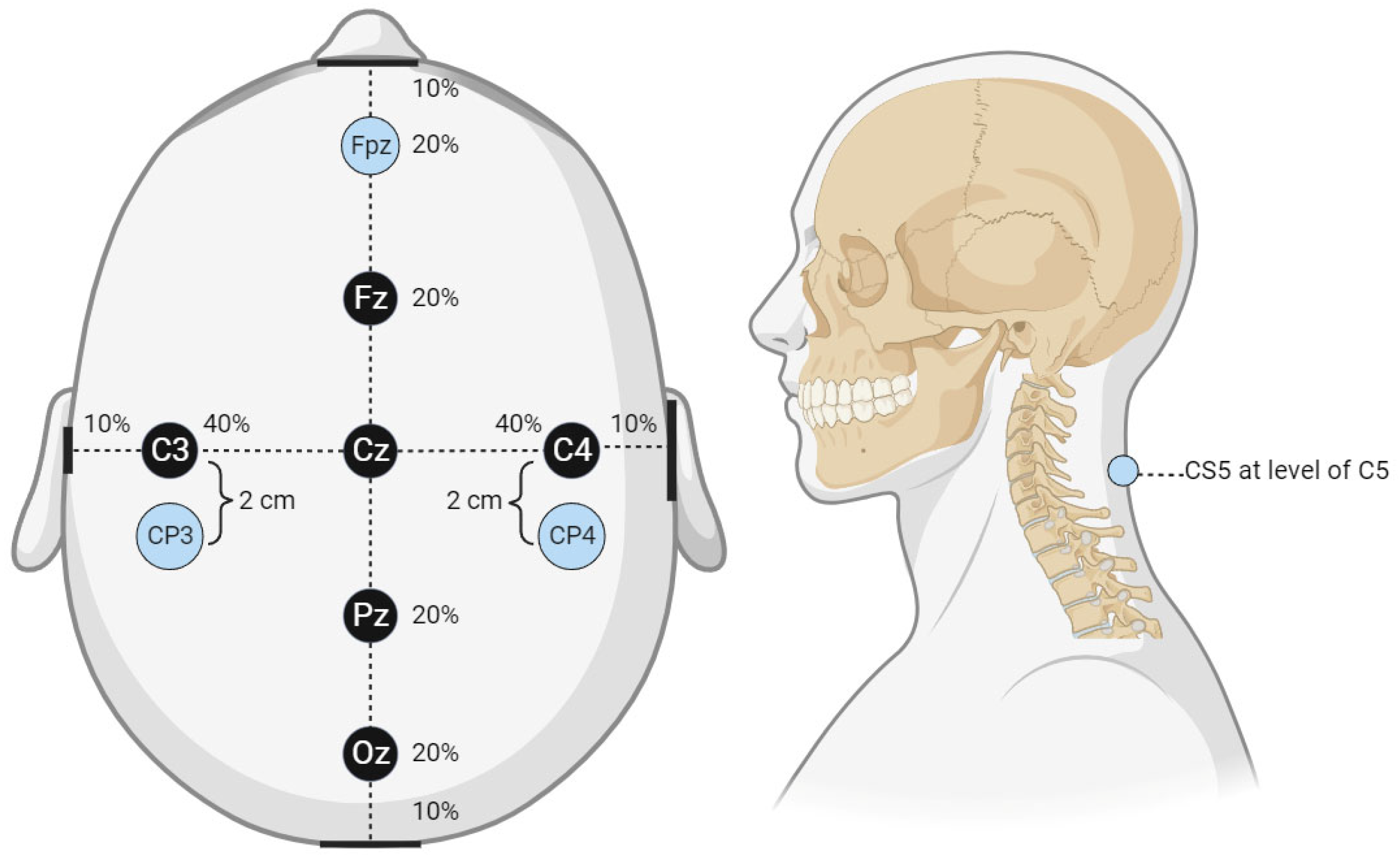
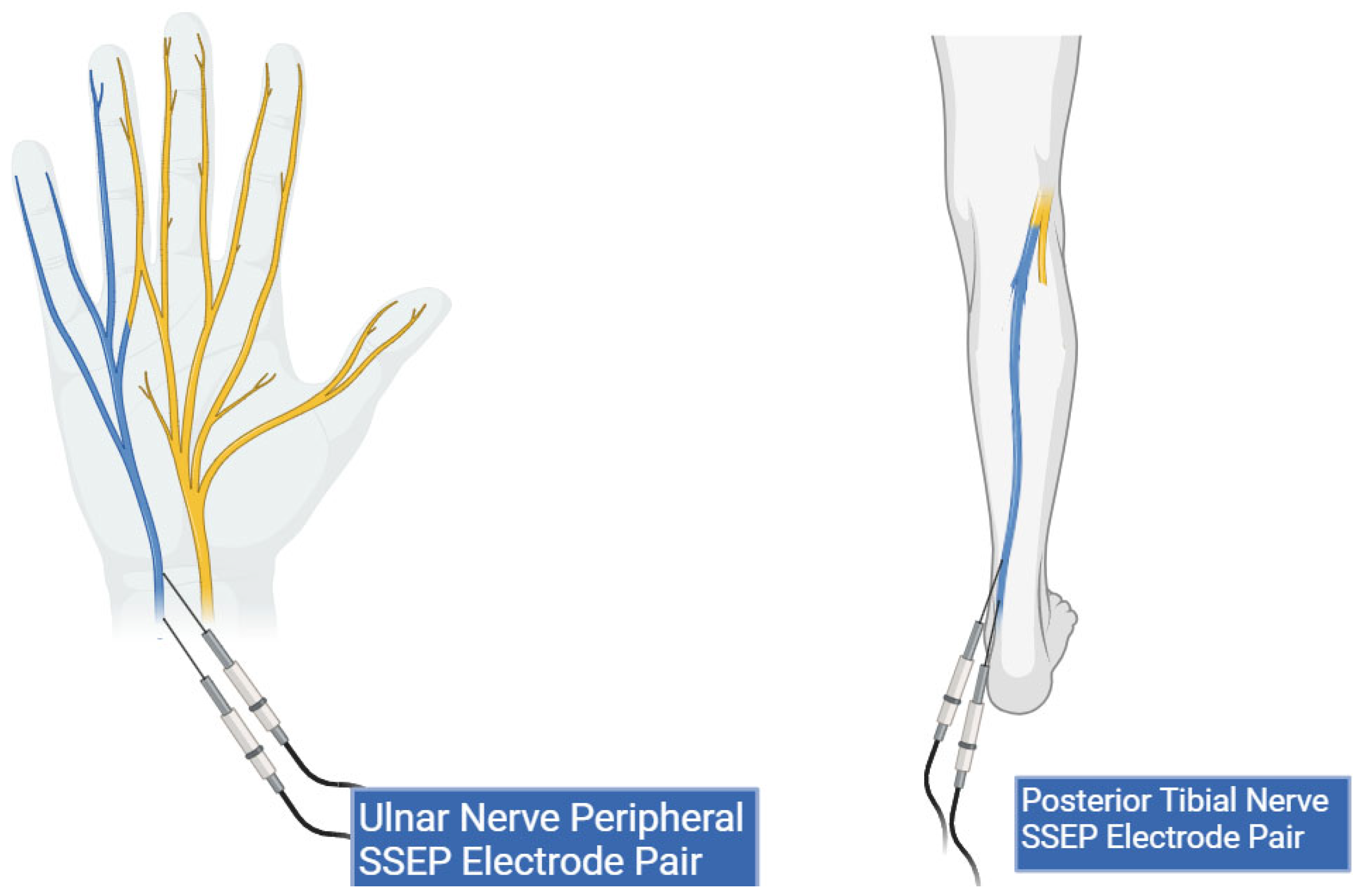
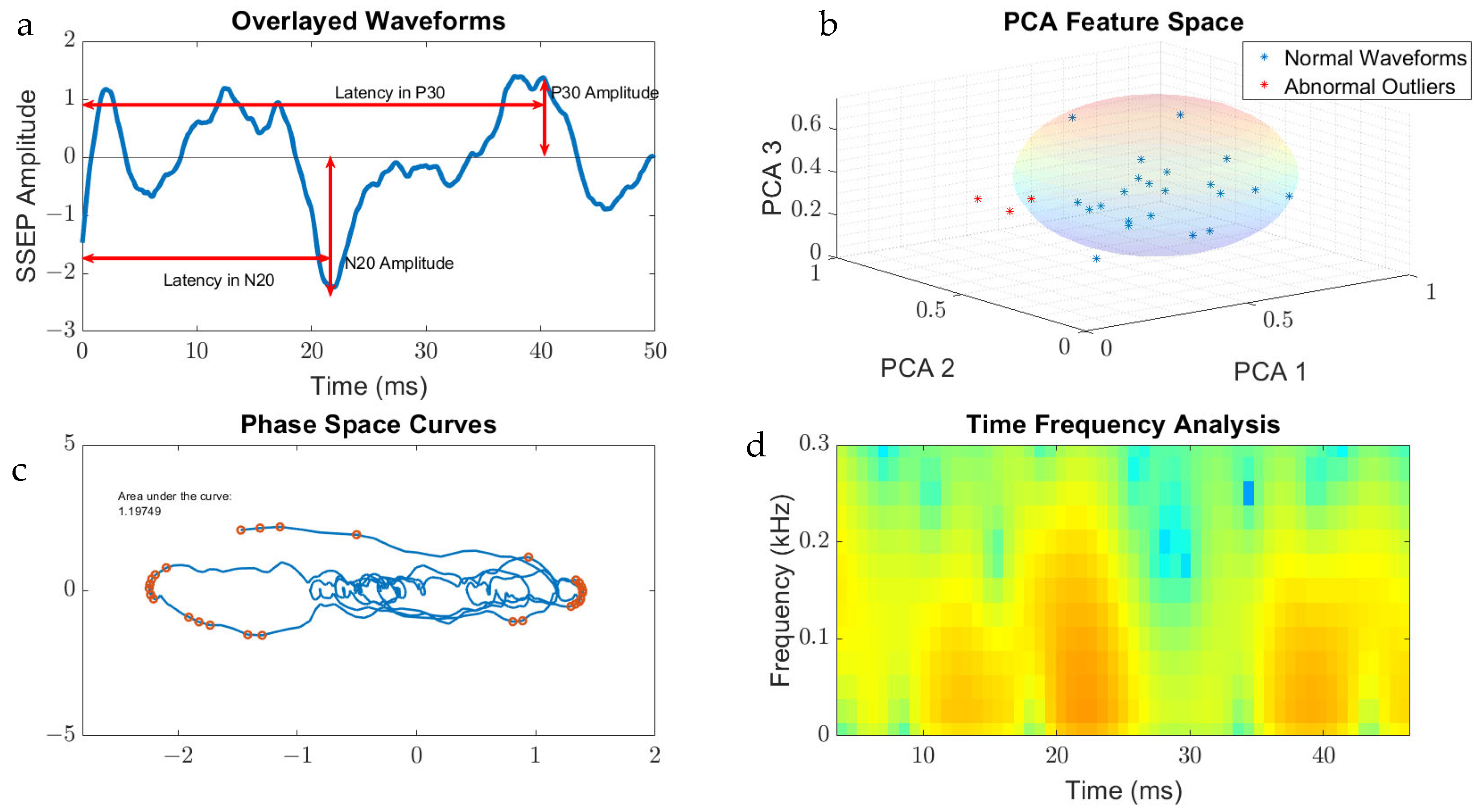

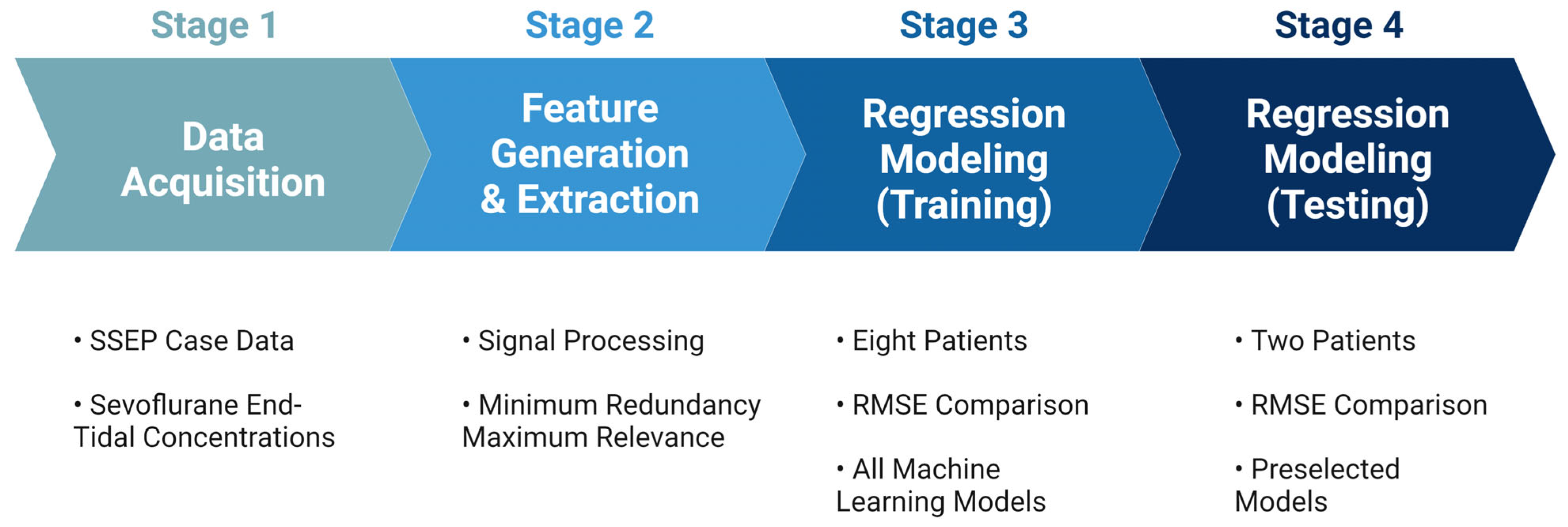
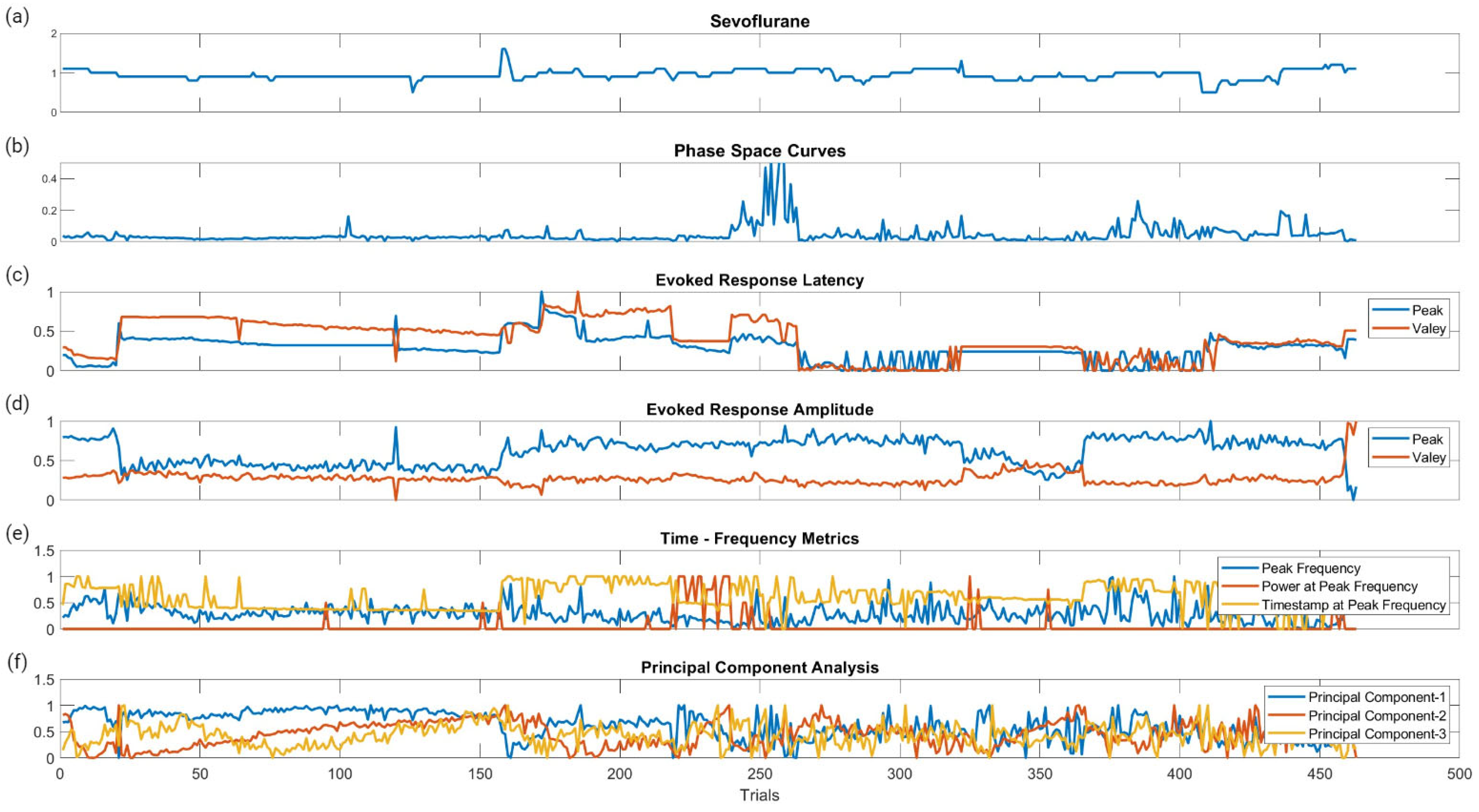



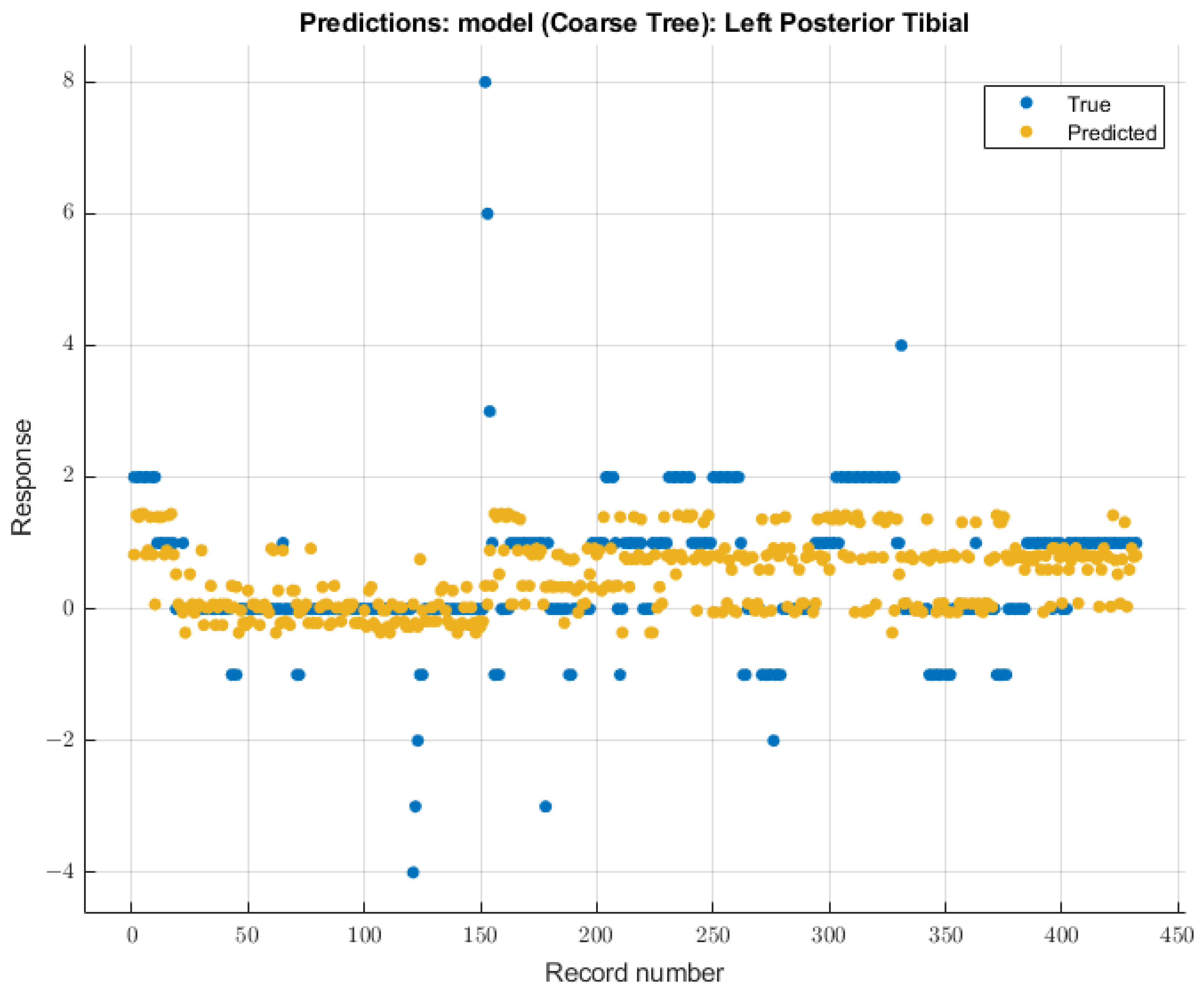
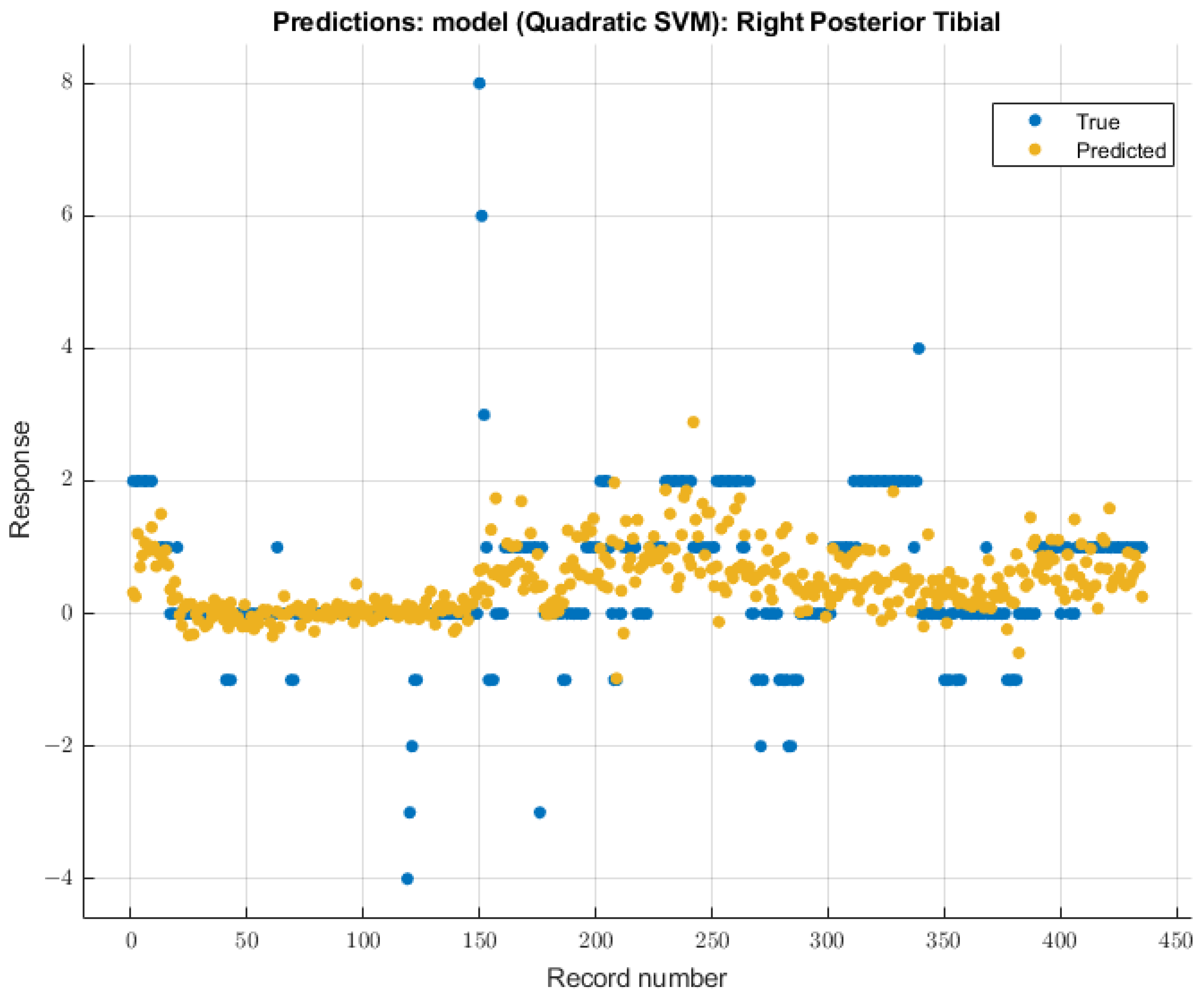
| Patient Number | Gender | Age | Procedure |
|---|---|---|---|
| 1 | Male | 62 | Lumbar Decompression and Fusion |
| 2 | Male | 74 | Lumbar Decompression and Fusion |
| 3 | Male | 60 | Lumbar Decompression and Fusion |
| 4 | Female | 52 | Lumbar Decompression and Fusion |
| 5 | Male | 51 | Lumbar Decompression and Fusion |
| 6 | Male | 50 | Lumbar Decompression and Fusion |
| 7 | Female | 63 | Lumbar Decompression and Fusion |
| 8 | Female | 66 | Thoracic Decompression and Fusion |
| 9 | Male | 49 | Lumbar Decompression and Fusion |
| 10 | Male | 61 | Lumbar Extradural Tumor Excision and Fusion |
| Left Ulnar | Right Ulnar | Left Posterior Tibial | Right Posterior Tibial | |
|---|---|---|---|---|
| Model | Coarse Tree | Quadratic SVM | Coarse Tree | Quadratic SVM |
| RMSE (Validation) | 0.91699 | 0.96147 | 1.0229 | 0.99482 |
| R–Squared (Validation) | 0.23 | 0.09 | 0.03 | 0.1 |
| MSE (Validation) | 0.84086 | 0.92442 | 1.0464 | 0.98968 |
| MAE (Validation) | 0.57944 | 0.5955 | 0.66129 | 0.62981 |
| Prediction Speed (Observations/sec) | 5300 | 27,000 | 23,000 | 27,000 |
| Training Time (Sec) | 12.712 | 5.0486 | 2.1419 | 2.4806 |
| Test Results (RMSE) | 2.3247 | 2.4047 | 2.244 | 2.17 |
| Property | Value |
|---|---|
| Box Constraint | 0.7413 |
| Cache Size | 103 |
| Caching Method | Queue |
| Clip Alphas | 1 |
| Epsilon | 0.0741 |
| Gap Tolerance | 10−3 |
| Iteration Limit | 106 |
| Kernel Function | Polynomial |
| Kernel Scale | Auto |
| Solver | SMO |
| Standardize Data | 1 |
| Save Support Vectors | 1 |
| Version | 2 |
| Type | Regression |
| Property | Value |
|---|---|
| Preset | Quadratic SVM |
| Kernel Function | Quadratic |
| Kernel Scale | Automatic |
| Box Constraint | Automatic |
| Epsilon | Automatic |
| Standardize Data | Yes |
| Property | Value |
|---|---|
| Split Criterion | MSE |
| Minimum Parent | 72 |
| Minimum Leaf | 36 |
| Maximum Splits | 406 |
| NVar To Sample | All |
| Merge Leaves | On |
| Prune | On |
| Prune Criterion | MSE |
| QEToler | 10−6 |
| NSurrogate | Off |
| Maximum Cat | 10 |
| AlgCat | Auto |
| Predictor Selection | All Splits |
| Use Chi-Square Test | 1 |
| Version | 3 |
| Method | Tree |
| Property | Value |
|---|---|
| Preset | Coarse Tree |
| Minimum Leaf Size | 36 |
| Surrogate Decision Splits | Off |
Disclaimer/Publisher’s Note: The statements, opinions and data contained in all publications are solely those of the individual author(s) and contributor(s) and not of MDPI and/or the editor(s). MDPI and/or the editor(s) disclaim responsibility for any injury to people or property resulting from any ideas, methods, instructions or products referred to in the content. |
© 2023 by the authors. Licensee MDPI, Basel, Switzerland. This article is an open access article distributed under the terms and conditions of the Creative Commons Attribution (CC BY) license (https://creativecommons.org/licenses/by/4.0/).
Share and Cite
Wilson, J.P., Jr.; Kumbhare, D.; Ronkon, C.; Guthikonda, B.; Hoang, S. Application of Machine Learning Strategies to Model the Effects of Sevoflurane on Somatosensory-Evoked Potentials during Spine Surgery. Diagnostics 2023, 13, 3389. https://doi.org/10.3390/diagnostics13213389
Wilson JP Jr., Kumbhare D, Ronkon C, Guthikonda B, Hoang S. Application of Machine Learning Strategies to Model the Effects of Sevoflurane on Somatosensory-Evoked Potentials during Spine Surgery. Diagnostics. 2023; 13(21):3389. https://doi.org/10.3390/diagnostics13213389
Chicago/Turabian StyleWilson, John Preston, Jr., Deepak Kumbhare, Charles Ronkon, Bharat Guthikonda, and Stanley Hoang. 2023. "Application of Machine Learning Strategies to Model the Effects of Sevoflurane on Somatosensory-Evoked Potentials during Spine Surgery" Diagnostics 13, no. 21: 3389. https://doi.org/10.3390/diagnostics13213389
APA StyleWilson, J. P., Jr., Kumbhare, D., Ronkon, C., Guthikonda, B., & Hoang, S. (2023). Application of Machine Learning Strategies to Model the Effects of Sevoflurane on Somatosensory-Evoked Potentials during Spine Surgery. Diagnostics, 13(21), 3389. https://doi.org/10.3390/diagnostics13213389





